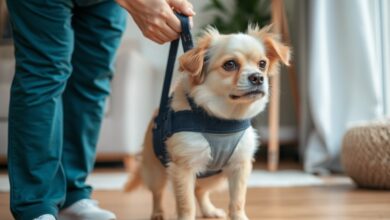How Long Does Dysphoria Last in Dogs After Surgery? Recovery Guide

Understanding how long dysphoria lasts in dogs after surgery is important for pet owners. This guide will help you recognize symptoms, manage your dog’s recovery, and know when to seek veterinary help. Let’s explore the key points about post-surgical dysphoria in dogs and how to support your furry friend during this time.
Key Takeaways
- Dysphoria is a state of confusion or discomfort that dogs may experience after surgery.
- The duration of dysphoria can range from a few hours to several days, depending on various factors.
- Providing a calm and comfortable recovery environment can help ease dysphoria symptoms.
- Monitoring your dog’s behavior is crucial to identify any signs of prolonged dysphoria.
- Consult your veterinarian if symptoms persist or worsen beyond the expected recovery timeline.
Understanding Post-Surgical Dysphoria in Dogs

Post-surgical dysphoria in dogs is a state of discomfort that can occur after surgery. This condition can be distressing for both pets and their owners. Understanding the symptoms and causes is essential for effective recovery.
Common Symptoms of Dysphoria
Recognizing the signs of dysphoria is crucial. Here are some common symptoms to watch for:
- Restlessness or agitation
- Whining or vocalization
- Disorientation or confusion
- Changes in appetite
- Altered sleep patterns
- Unusual aggression or fear responses
Causes of Dysphoria After Surgery
Several factors can trigger dysphoria in dogs post-surgery:
- Anesthesia effects: The lingering impact of anesthesia can lead to confusion.
- Pain: Surgical procedures often result in pain, causing distress.
- Hormonal changes: Surgeries involving reproductive organs can cause hormonal imbalances.
- Environmental stress: Unfamiliar sights, sounds, and smells at the veterinary clinic can overwhelm pets.
Differences Between Pain and Dysphoria
It’s important to differentiate between pain and dysphoria:
- Pain is a physical sensation that can be managed with medication.
- Dysphoria is a state of unease that may not always be linked to physical pain.
Understanding these differences can help in providing the right care for your dog during recovery. Monitoring your pet closely after anesthesia is vital to ensure they have a quiet place to rest and recover.
Typical Timeline for Dysphoria in Dogs After Surgery
Understanding the timeline for dysphoria in dogs after surgery can help pet owners provide better care. Dysphoria can vary significantly based on several factors, including the type of surgery and the individual dog’s health.
Immediate Post-Operative Period
- Duration: 0-24 hours
- Most dogs experience intense dysphoria during this time.
- The effects of anesthesia are strongest, leading to confusion and disorientation.
Short-Term Recovery Phase
- Duration: 1-3 days
- Symptoms of dysphoria begin to decrease, but some behavioral changes may still be present.
- Pain management is crucial during this phase to ensure comfort.
Medium-Term Recovery Phase
- Duration: 4-7 days
- Many dogs return to their normal behavior, but some may still show mild signs of dysphoria.
- Monitoring for complications is essential during this time.
Long-Term Recovery Phase
- Duration: Beyond 1 week
- Most dogs fully recover from dysphoria, but persistent symptoms may indicate other issues.
| Recovery Phase | Duration | Common Symptoms |
|---|---|---|
| Immediate Post-Operative | 0-24 hours | Confusion, disorientation |
| Short-Term Recovery | 1-3 days | Behavioral changes, mild discomfort |
| Medium-Term Recovery | 4-7 days | Return to normal behavior |
| Long-Term Recovery | Beyond 1 week | Full recovery or persistent symptoms |
Understanding this timeline can help you better support your dog during recovery. Keep an eye on their behavior and consult your vet if you notice any concerning signs.
Factors Influencing Dysphoria Duration in Dogs

Understanding how long dysphoria lasts in dogs after surgery is essential for pet owners. Several factors can affect the duration of this condition, including:
Type of Surgery Performed
- Orthopedic surgeries often lead to longer dysphoria, lasting 3-7 days due to pain and limited movement.
- Soft tissue surgeries typically result in dysphoria lasting 2-5 days, depending on the organ involved.
- Dental procedures can cause dysphoria for 1-2 days, influenced by the number of extractions and the dog’s dental health.
Individual Dog’s Temperament and Health
- Dogs with a calm temperament may recover faster than those who are anxious or stressed.
- Pre-existing health conditions can prolong dysphoria, making recovery more challenging.
Age and Pre-Existing Conditions
- Younger dogs generally recover quicker than older dogs.
- Dogs with chronic health issues may experience longer dysphoria due to their overall health status.
Post-Operative Care and Environment
- A comfortable recovery environment can significantly reduce dysphoria duration. Ensure your dog has a quiet space to rest.
- Proper pain management is crucial. Follow your vet’s instructions on medications to help ease discomfort.
Providing attentive care and a supportive environment can greatly influence your dog’s recovery journey.
By considering these factors, you can better understand and manage your dog’s recovery process after surgery.
Managing Post-Surgical Dysphoria in Dogs
Pain Management Strategies
Effective pain management is essential for reducing dysphoria in dogs after surgery. Here are some strategies to consider:
- Follow your vet’s instructions on pain medications.
- Use prescribed pain relievers and anti-inflammatory drugs.
- Consider natural remedies, but only under veterinary guidance.
Creating a Comfortable Recovery Environment
A peaceful environment can help ease your dog’s discomfort. To create a suitable space:
- Set up a cozy bed in a quiet area.
- Use soft lighting and minimize loud noises.
- Keep the room at a comfortable temperature.
Monitoring and Observing Your Dog
Keeping a close eye on your dog during recovery is crucial. Make sure to:
- Watch for any changes in behavior or symptoms.
- Ensure proper wound healing.
- Follow all post-operative care instructions from your vet.
Nutritional Support and Hydration
Proper nutrition and hydration can speed up recovery. Here’s how to help:
- Offer small, frequent meals.
- Provide easily digestible food.
- Encourage your dog to drink water regularly.
Remember, a calm and supportive environment can significantly reduce the duration of dysphoria.
By implementing these strategies, you can help your dog recover more comfortably and effectively manage post-surgical dysphoria. Postoperative opioid-free analgesia can also be beneficial in ensuring a smoother recovery process.
Recognizing and Addressing Prolonged Dysphoria
Signs of Prolonged Dysphoria
Recognizing when your dog is experiencing prolonged dysphoria is crucial for their recovery. Look for these warning signs:
- Worsening symptoms after 48 hours.
- No improvement in behavior after 3-4 days.
- Persistent vomiting or diarrhea.
- Refusal to eat or drink for more than 24 hours.
- Signs of severe pain despite medication.
- Excessive bleeding or discharge from the surgical site.
- Difficulty breathing or extreme lethargy.
When to Seek Veterinary Help
If you notice any of the signs mentioned above, it’s important to consult your veterinarian. Early intervention can prevent further complications and ensure your dog receives the care they need.
Potential Complications of Prolonged Dysphoria
Prolonged dysphoria can lead to serious health issues, including:
- Increased pain and discomfort.
- Risk of infection at the surgical site.
- Behavioral changes due to stress and anxiety.
- Longer recovery times.
Prolonged dysphoria can significantly impact your dog’s overall health and well-being. Monitoring your dog’s recovery closely is essential to address any issues promptly.
By being vigilant and proactive, you can help your dog navigate through their recovery more comfortably and effectively.
Preemptive Measures to Minimize Dysphoria

While some level of dysphoria is often unavoidable, there are steps you can take to minimize its impact and duration. Consider the following preemptive measures:
Pre-Surgery Preparation
- Follow all pre-surgical instructions from your vet.
- Familiarize your dog with any recovery equipment, like crates or e-collars.
- Prepare a comfortable recovery space in advance.
Choosing the Right Veterinary Team
- Research veterinary clinics in your area.
- Ask about their post-operative care protocols.
- Inquire about pain management techniques used.
Diligent Aftercare
- Attend all follow-up appointments to ensure good aftercare.
- Administer medications as prescribed.
- Slowly return to normal activities under the supervision of a veterinarian.
Taking these steps can help ensure a smoother recovery for your dog, reducing the chances of prolonged dysphoria.
By being proactive, you can help your dog recover more comfortably and quickly after surgery.
Final Thoughts on Managing Dysphoria in Dogs After Surgery
In summary, the time dysphoria lasts in dogs after surgery can vary, but most dogs start to feel better within a week. To help your furry friend during this tough time, create a calm and cozy space for them, follow your vet’s advice, and keep an eye out for any problems. Remember, every dog is unique, and their recovery may differ. If you notice any worrying signs or if your dog isn’t improving, don’t hesitate to reach out to your veterinarian. With the right care and attention, your dog will soon be back to their happy self.
Frequently Asked Questions
What is dysphoria in dogs after surgery?
Dysphoria in dogs after surgery is a state where they seem confused, restless, or unhappy. It often happens due to the effects of anesthesia or pain.
How long does dysphoria usually last in dogs?
Typically, dysphoria lasts from a few hours to a few days after surgery, depending on the type of surgery and the dog’s individual response.
What are the signs that my dog is experiencing dysphoria?
Signs include whining, pacing, disorientation, changes in appetite, and difficulty settling down.
What can I do to help my dog during this time?
Create a calm and comfortable space for your dog, follow pain management instructions from your vet, and keep a close eye on their behavior.
When should I contact my vet about my dog’s dysphoria?
If your dog’s symptoms worsen after 48 hours, or if they show signs of severe pain or other concerning behaviors, it’s important to reach out to your vet.
Can I prevent dysphoria in my dog after surgery?
While you can’t completely prevent it, proper pre-surgery preparation, choosing a good veterinary team, and following post-operative care can help minimize its effects.





